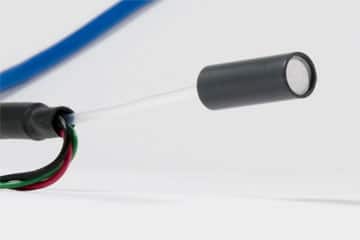 When pressure is used to calculate level in a tank or well, gage pressure (PSIG) is the unit of choice. Gage pressure uses atmospheric, or ambient, pressure as its reference point. In other words, it only tells you the pressure that the liquid column is creating, not the pressure that the atmosphere is creating.
When pressure is used to calculate level in a tank or well, gage pressure (PSIG) is the unit of choice. Gage pressure uses atmospheric, or ambient, pressure as its reference point. In other words, it only tells you the pressure that the liquid column is creating, not the pressure that the atmosphere is creating.
On a standard pressure transmitter, establishing atmospheric pressure as the reference point is done by venting the inner chamber of the sensor to atmosphere. All it takes is a very small hole on the housing and a waterproof membrane.
However, as a submersible pressure sensor is under water, poking a hole in the housing is not an option. So venting to atmosphere is done with a vent tube.
A submersible pressure transmitter without a vent tube would be reading either sealed or absolute pressure. Sealed pressure means the sensor housing is sealed at the factory during manufacture. So the ambient atmospheric pressure at the time and location of manufacture is the reference point. This reference point will move relative to ambient pressure depending on elevation and on the weather. This dramatically reduces accuracy if not accounted for by some other means.
Absolute pressure uses absolute zero, or full vacuum, as it’s reference point. The reference point will not move relative to ambient pressure, but includes ambient in the reading.
For most applications, however, the vent tube is a critical part of the submersible sensor, as it provides accurate readings that are automatically compensated for surface air pressure.
If you have a vent tube, that means you also have a highway to the electronics of your sensor for moisture and gasses. To be effective, the tube must be protected. For that reason, we have a few different options for protecting the tube from moisture and debris.
A simple desiccant cartridge is effective against moisture when installed properly. The cartridge is sealed to the tube using heat shrink tubing, and should be located inside a control box or cabinet. The disadvantages of a desiccant cartridge are that it is a bit bulky and must be replaced when the blue desiccant turns pink.
We have also invented a vent cap with a hydrophobic membrane that allows the tube to breathe, similar to Gore-Tex®. The vent cap is about the size of a pen cap, and uses a gasket, rather than heat shrink tubing, to seal to the vent tube. Unlike the desiccant cartridge, the cap does not need replacement as long as it’s kept clean.
Unfortunately, the protection we’ve provided against moisture is ineffective against corrosive gasses. So if your submersible pressure transducer is installed where gasses could penetrate the vent tube, you ought to consider a sealed or absolute unit.
This situation is rare, thankfully. But it can happen. If you’ve had unknown failures with submersible pressure transmitters, you may be dealing with corrosive gas. Make sure you’re familiar with what gasses may be present near the sensor and discuss this with your supplier.
Your vent tube is embedded in the cable so it can reach the control box where the wires are connected to the control system. The control box provides a natural protection for the tube, and is an ideal place to house the vent cap or desiccant cartridge. However, it also means the cable must be handled with relative care.
If the cable is kinked or torn in any place, the tube will likely be compromised. It’s not difficult to keep the cable in good condition, but carelessness could result in sensor failure. Route your cable in a safe and protected path.
We are experts on the topic of submersible pressure transducers. Come to us with your questions, comments, or concerns about using submersible pressure sensors. We’re happy to help, even if it means you need to use something else.